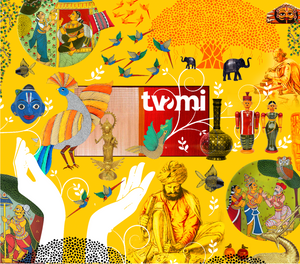Born in 1988 in Musthuli Village located in Purab Bardhaman District of West Bengal, Ashish always knew he wanted to pursue weaving, like his father and grandfather. Growing up, he observed them interweave fine yarns into beautiful fabrics on a handloom. The intricate process of creating rich vibrant motifs is what caught his attention the most. Ashish understood very well that interlacing these motifs which characterise handloom jamdani textiles is no easy feat, yet he was confident of rising up to the challenge.
There are four villages in Purba Bardhaman where jamdani weaving is practiced. Ashish’s native Musthuli village is one of them. Almost 300 families from these villages are involved in jamdani weaving. Even though these weaving clusters are very old, jamdani was introduced here much later. It only garnered traction post the partition, when there was an influx of a large number of jamdani weavers from Bangladesh into the region. Ashish's own grandfather was engaged in tussar weaving at the time and learnt the art of jamdani weaving from the migrant weavers.
Weaving has conventionally been a combined family effort and it is no differnet in Ashish’s household. Currently, all 8 members of his family and all involved in the weaving process. Women also help in different processes after finishing the household work. Tassel making is solely done by female family members. While previously, they used to weave only sarees, but keeping with contemporary preferences of market demand, they have started weaving dupatta, stoles and yardage as well.
They sell most of the end products to the Mahajan while some of the weaves are sold directly to store owners in Kolkata. They are keen to work with designers from the city as it will help them learn new and urban colour combinations and motifs. According to Ashish, knowledge about handloom jamdani needs to be spread among consumers for them to be able to distinguish them from machine made copies. He believes the vibrant weaves which are completed with painstaking effort reflect why they were considered amongst the finest textiles in the world at one point. He adds that the craft has enormous potential and it is just about reconnecting the patrons back to the true craft which will ensure it thrives and the weavers prosper.



